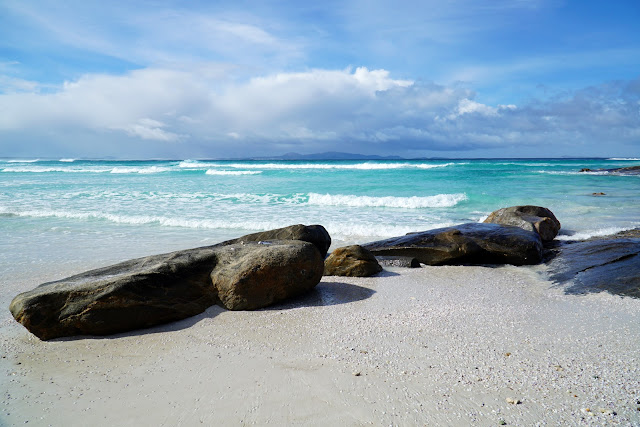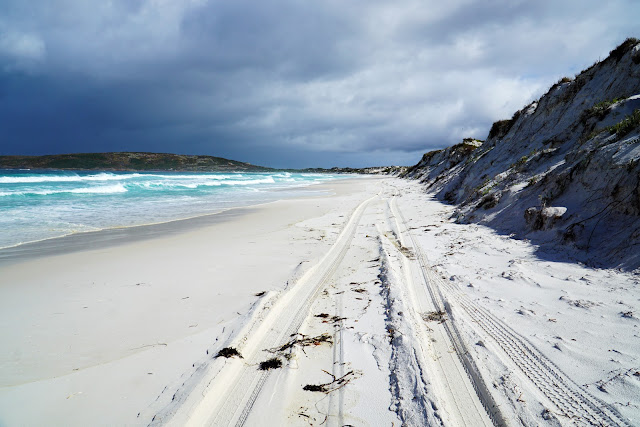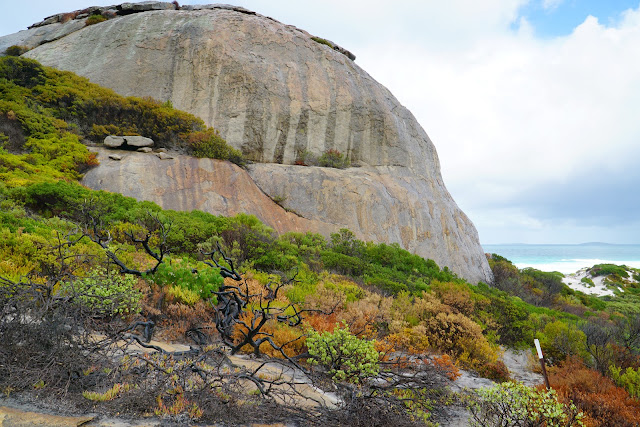An excellent coastal walk in Cape Arid National Park, the Tagon Coastal trail explores the coastline between Thomas River and Tagon Point. Starting at the sands of Yokinup Bay, the trail winds its way over dramatic granite headlands and sandy beaches as it makes it way south-west to the dramatic view of Tagon Point. With rugged walking and views of the wild Southern Ocean, this is an outstanding trail worth the detour if in the area
Distance: 15 km (return)
Gradient: A few moderate descents and ascents, with some flat beach walking
Quality of Path: Largely clear and well maintained; a mix of unmodified granite walking, purpose built walk trails through the dunes and stretches of beach walking
Quality of Signage: Largely well signed, with wooden pegs marking the way, and informative trailheads at access point
Experience Required: Previous Bushwalking Experience Recommended
Time: 4-5 Hours
Steps: Several formal and informal steps along the track, particularly along the ascent and descents from the beaches
Best Time to Visit: Autumn-Spring
Entry Fee: Yes. National Park fees apple
Getting There: From Esperance, take Fisheries Rd east and follow signs to Cape Arid along Tagon Rd. At the end of Tagon Rd turn right onto Merivale Rd and take the immediate left turn onto Thomas River Rd. Follow the road all the way to just before the beach. Trailhead is located along the roadEntry Fee: Yes. National Park fees apple
After a cold and blustery Good Friday driving from Denmark to Esperance, Alissa and I headed out early in the morning for the first walk of our south coast Western Australia road trip. Our itinerary was fairly simple - head out to the walk furthest east and work our way back along the coast to Cape Le Grand and then Fitzgerald River before returning to Denmark to chill out. Our first stop was Cape Arid - a massive coastal national park that has always seemed extremely distant and remote compared to our usual coastal holidays in Albany/Denmark and Margaret River, and the extremely muddy and slippery road into the park did make for a somewhat unwelcoming start to the journey (even if I did enjoy the drive).
The reason we were out this way was the Tagon Coastal Trail. For whatever reason, this only recently came onto my radar as it is not an extremely well known and publicised track, however it is certainly well regarded enough by those in the know to have been given the Google Trekker treatment. Information online has been confusingly vague about its length, however the idea of a 7-15 kilometre coastal walk along granite headlands, white beaches and alongside stunning aquamarine waters looked like something right up our alley.
From the trailhead at the end of Thomas River Rd, the walk begins by following the track right to the beach. Not really in the mood to deflate our tyres just to get onto the sand, Alissa and I parked our car along the road, however it would be possible to drive right onto the beach and start the walk from there.
Immediately, Alissa and I were taken by how stunningly blue the water was against the white sandy beach of Yokinup Bay. While the swell was still fairly strong, the weather had certainly calmed down a bit from the previous day, and we were glad to be experiencing it with what I would consider the best of both worlds - dramatic, wild oceans with sunny skies and just enough cloud to provide some interest.
Leaving the beach, the purpose built trail begins as it heads up along the granite headlands. Old school wooden peg markers similar to those seen in the Stirling Range mark the way, and are in relatively good condition consider they are probably quite old and have to face the full force of the Southern Ocean on a daily basis.
The trail heads out along the granite headlands to the furthest point of Yokinup Bay before turning right.
The trail here begins to rise. While the granite was wet from the rains overnight, Alissa and I found it to be surprisingly grippy, all things considered. While there are plenty of granite-based walks throughout Western Australia, for walking up wet granite slope reasons this walk brought back memories of the Three Mountains Walk GPS Route in Monadnocks Conservation Park, but made all the better by the excellent coastal views.
With the terrain closer to the water looking far too sloped for safe and comfortable hiking, the trail heads inland through the coastal heath.
Cape Arid National Park had suffered some severe fires earlier in the year, however the Tagon area got away largely unscathed. The heath here did however look like it had been burnt at least fairly recently, with the fairly light touch suggesting it must have been a genuinely controlled burn.
After a short section of easy, flat walking through the heath, the trail begins its descent along the granite towards Dolphin Cove.
The route the trail takes is delightfully rugged and close to the coast, and I appreciated that the adventurous aspect hadn't been risk assessed into boredom as has been the case with other walks in Western Australia.
It was great to be able to see the massive waves crashing into the granite headlands at a distance that was close enough to appreciate its wildness while being far away enough for it to not be unnecessarily risky.
Clambering over a section of granite boulders, Alissa and I made it to the sands of Dolphin Cove.
Dolphin Cove is the second longest beach walk of the trail, however it is only a mercifully short 550 metres. Dolphin Cove is another stunning beach, and on the day of our walk the sand was fairly firm under foot. The waves were pretty rough however, and I would question the wisdom of using it as a swimming beach on all but the calmest of days.
On the other side of Dolphin Cove, the track rises up along another stretch of granite headlands. This area appears to be a popular but potentially dangerous rock fishing spot, and signs nearby indicate that there are a number of anchor points to tie oneself down to when fishing. An emergency rescue 'angel ring' along the rocks also serves as a clear indicator of the potential danger that can come with this particularly risky subgenre of shore fishing.
The trail heads inland slightly and leads to Dolphin Cove car park. This access point can be used for those looking to do a shorter version of the walk by starting here and continuing onto to either Yokinup Bay or Kennedy Beach.
Descending a series of steps from the headlands, the trail leads to the small but charismatic Little Tagon Bay. The smallest beach along the Tagon Coastal Trail, the waters of the bay were some of the most stunning but wild Alissa and I have seen, and it was probably my favourite beach of the walk.
Along the southern corner of the beach, the waves continuously crashed into the rocks, putting on a dramatic show of the Southern Ocean's power.
Another extended section of granite headland walking ensues after Little Tagon Bay, mostly keeping inland of the headland's high point.
A section marked with the kind of 'sculptural graffiti' that has become very trendy to hate on proved to be one of the only slippery sections of the walk, as the considerable slope made it a bit difficult for our shoes to fully grip onto. Nevertheless, walking slowly and carefully meant we were able to make it along the rocks without incident.
Descending from the granite and into dense coastal heath, Alissa and I followed the winding, sandy trail towards Tagon Bay.
At this point we couldn't help but notice that our good fortune regarding the weather was about to change, as we were not heading towards dark clouds on the horizon as they were also heading towards us.
At over two kilometres in length, Tagon Bay is by far the longest stretch of beach walking along the Tagon Coastal Trail, made all the longer by the fact the return walk nature of the trail means walkers have to do these two kilometres twice.
Less than halfway along the beach, Alissa and I began to be hit by fairly heavy rain, and Alissa found it difficult to see with the rain hitting her glasses. After complaining about how much she wasn't enjoying it now, we agreed she would wait it out by sitting out of the wind behind a sand dune while I continue onwards to the end of the trail.
The complete second half of the beach walk was a constant downpour and I kept my camera away to prevent it getting damaged. Upon reaching the end of the beach, the rain became a mild drizzle before stopping altogether a few metres up the granite headland.
With the rain dying down I could also see that I was going to be incredibly lucky, with clear skies greeting me at the end of the walk at Kennedy Beach.
A massive granite dome along the track provides an outstanding penultimate feature for the walk, with the track skirting just below it.
Passing the southern trailhead, the trail's last few metres leads down to Kennedy Beach itself.
At the beach, the view of the stunningly rugged Tagon Point provides a spectacular end to the walk. Interestingly for a beach that does not appear to have any easy access, the Cape Arid National Park sign seems to indicate that it is possible drive a four wheel drive down the beach to this point and enter the park from this alternate access point, and indeed the Google Trekker image shows a Parks and Wildlife ute parked up on the beach.
Having completed the walk all the way to its end Tagon Point, I now retraced my steps back to Alissa along Tagon Bay before the two us made the journey back to Yokinup Bay.
Having only heard of the Tagon Coastal Trail in the last few years and with very little information available online, Alissa and I didn't know what to expect with this walk. What we found was a pleasant surprise - a truly spectacular and genuinely world class coastal day walk. I can see why DBCA picked this as a walk worthy of being covered by their Google Trekker project, and I'm slightly surprised that the walk is not included in the Trails WA's Top Trails as it is certainly good enough to earn of the title. While its remote location is probably a hindrance to it becoming more well known, visitors to Esperance or Cape Le Grand National Park will find a lot to enjoy about Cape Arid, and I would definitely recommend this to anyone making the road trip out to this spectacular part of the south coast of Western Australia.














































0 comments:
Post a Comment